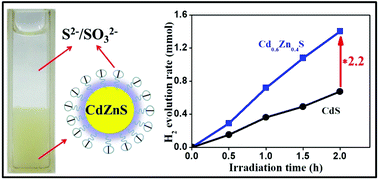One-step facile synthesis and high H2-evolution activity of suspensible CdxZn1−xS nanocrystal photocatalysts in a S2−/SO32− system†
Abstract
For a CdS-based photocatalyst, both the photocorrosion resistance and the rapid H2-production reaction are highly required for improving its photocatalytic H2-production performance. In this study, a facile strategy was reported to simultaneously realize an improved photocorrosion resistance and rapid interfacial H2-evolution reaction of CdxZn1−xS solid–solution photocatalysts in a sulfur-rich S2−/SO32− solution. Here, the suspensible CdxZn1−xS nanocrystal photocatalysts are prepared by a one-step co-precipitation route through the direct introduction of Zn2+/Cd2+ mixing ions in a sulfur-rich Na2S–Na2SO3 solution, and the resultant CdxZn1−xS nanocrystals (ca. 5 nm) display a suspensible structure owing to the numerous and selective adsorption of S2−/SO32− on the surface of these CdxZn1−xS nanocrystals. It is found that the bandgap structure of CdxZn1−xS (from 2.25 to 3.52 eV) nanocrystals can be easily controlled by adjusting the Cd2+/Zn2+ molar ratio. The photocatalytic experimental results suggested that the suspensible CdxZn1−xS nanocrystal photocatalysts clearly displayed an excellent photocatalytic H2-production performance, and the suspensible Cd0.6Zn0.4S nanocrystals exhibit the highest photocatalytic H2-generation performance of 717.19 μmol h−1, a value higher than that of the sole CdS (320.99 μmol h−1) and ZnS (5.89 μmol h−1) by a factor of 2.2 and 121.8 times, respectively. Based on the experimental results, a possible S2− active site-mediated mechanism accounted for the high H2-production activity of the suspensible CdxZn1−xS nanocrystals, namely the numerous adsorbed S2− ions not only function as efficient hole scavengers to rapidly consume the photogenerated holes, resulting in an improved photocorrosion resistance of suspensible CdxZn1−xS nanocrystals, but also serve as effective H+-capturing active sites to accelerate the interfacial H2-production reaction. Meanwhile, an optimum bandgap structure of suspensible CdxZn1−xS nanocrystals is also extremely required for promoting the photocatalytic H2-production activity. This research may provide advanced insights for developing stable and high-activity photocatalytic materials.



 Please wait while we load your content...
Please wait while we load your content...